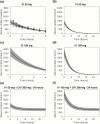Prevention of Adrenal Crisis: Cortisol Responses to Major Stress Compared to Stress Dose Hydrocortisone Delivery
- PMID: 32170323
- PMCID: PMC7241266
- DOI: 10.1210/clinem/dgaa133
Prevention of Adrenal Crisis: Cortisol Responses to Major Stress Compared to Stress Dose Hydrocortisone Delivery
Abstract
Context: Patients with adrenal insufficiency require increased hydrocortisone cover during major stress to avoid a life-threatening adrenal crisis. However, current treatment recommendations are not evidence-based.
Objective: To identify the most appropriate mode of hydrocortisone delivery in patients with adrenal insufficiency who are exposed to major stress.
Design and participants: Cross-sectional study: 122 unstressed healthy subjects and 288 subjects exposed to different stressors (major trauma [N = 83], sepsis [N = 100], and combat stress [N = 105]). Longitudinal study: 22 patients with preserved adrenal function undergoing elective surgery. Pharmacokinetic study: 10 patients with primary adrenal insufficiency undergoing administration of 200 mg hydrocortisone over 24 hours in 4 different delivery modes (continuous intravenous infusion; 6-hourly oral, intramuscular or intravenous bolus administration).
Main outcome measure: We measured total serum cortisol and cortisone, free serum cortisol, and urinary glucocorticoid metabolite excretion by mass spectrometry. Linear pharmacokinetic modeling was used to determine the most appropriate mode and dose of hydrocortisone administration in patients with adrenal insufficiency exposed to major stress.
Results: Serum cortisol was increased in all stress conditions, with the highest values observed in surgery and sepsis. Continuous intravenous hydrocortisone was the only administration mode persistently achieving median cortisol concentrations in the range observed during major stress. Linear pharmacokinetic modeling identified continuous intravenous infusion of 200 mg hydrocortisone over 24 hours, preceded by an initial bolus of 50-100 mg hydrocortisone, as best suited for maintaining cortisol concentrations in the required range.
Conclusions: Continuous intravenous hydrocortisone infusion should be favored over intermittent bolus administration in the prevention and treatment of adrenal crisis during major stress.
Keywords: cortisol; glucocorticoids; hydrocortisone; mass spectrometry; stress; surgery.
© Endocrine Society 2020.
Figures





Comment in
-
Letter to the Editor: "Prevention of Adrenal Crisis: Cortisol Responses to Major Stress Compared to Stress Dose Hydrocortisone Delivery".J Clin Endocrinol Metab. 2021 Jan 1;106(1):e393-e394. doi: 10.1210/clinem/dgaa709. J Clin Endocrinol Metab. 2021. PMID: 33027807 No abstract available.
-
Response to Letter to the Editor: "Prevention of Adrenal Crisis: Cortisol Response to Major Stress Compared to Stress Dose Hydrocortisone Delivery".J Clin Endocrinol Metab. 2021 Jan 1;106(1):e404-e406. doi: 10.1210/clinem/dgaa712. J Clin Endocrinol Metab. 2021. PMID: 33027808 Free PMC article. No abstract available.
-
Response to Letter to the Editor from Chee et al: "Prevention of Adrenal Crisis: Cortisol Response to Major Stress Compared to Stress Dose Hydrocortisone Delivery".J Clin Endocrinol Metab. 2021 Jan 1;106(1):e407-e408. doi: 10.1210/clinem/dgaa719. J Clin Endocrinol Metab. 2021. PMID: 33029637 Free PMC article. No abstract available.
-
Letter to the Editor: "Prevention of Adrenal Crisis: Cortisol Responses to Major Stress Compared to Stress Dose Hydrocortisone Delivery".J Clin Endocrinol Metab. 2021 Jan 1;106(1):e395-e396. doi: 10.1210/clinem/dgaa717. J Clin Endocrinol Metab. 2021. PMID: 33029644 No abstract available.
References
-
- Nicolaides NC, Kyratzi E, Lamprokostopoulou A, Chrousos GP, Charmandari E. Stress, the stress system and the role of glucocorticoids. Neuroimmunomodulation. 2015;22(1–2):6–19. - PubMed
-
- Bancos I, Hahner S, Tomlinson J, Arlt W. Diagnosis and management of adrenal insufficiency. Lancet Diabetes Endocrinol. 2015;3(3):216–226. - PubMed
-
- Broersen LH, Pereira AM, Jørgensen JO, Dekkers OM. Adrenal insufficiency in corticosteroids use: systematic review and meta-analysis. J Clin Endocrinol Metab. 2015;100(6):2171–2180. - PubMed
-
- Charmandari E, Nicolaides NC, Chrousos GP. Adrenal insufficiency. Lancet. 2014;383(9935):2152–2167. - PubMed
-
- Allolio B. Extensive expertise in endocrinology. Adrenal crisis. Eur J Endocrinol. 2015;172(3):R115–R124. - PubMed
Publication types
MeSH terms
Substances
Grants and funding
LinkOut - more resources
Full Text Sources
Medical

